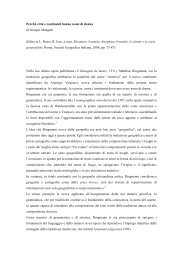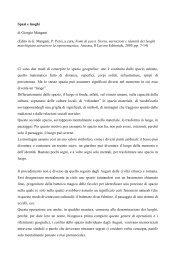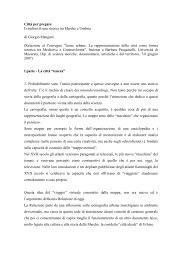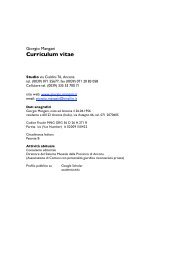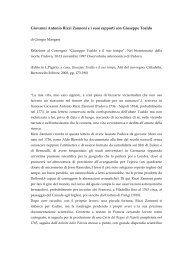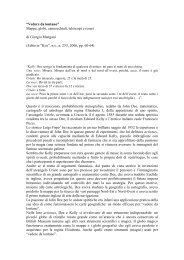Ortelius's Typus Orbis Terrarum (1570)
Ortelius's Typus Orbis Terrarum (1570)
Ortelius's Typus Orbis Terrarum (1570)
Create successful ePaper yourself
Turn your PDF publications into a flip-book with our unique Google optimized e-Paper software.
four more quotations in as many medallions set at the engraving‘s sides, and by a lively<br />
grotesque decoration, which replaces the light-blue background of the clouds, without loosing<br />
sight of the dimension of the "world seen from the outside".<br />
As Rodney Shirley pointed out,5 geographic integrations in this third state are modest; they<br />
only adopt a more correct form of South America and introduce Solomon Islands, without<br />
inserting the more recent discoveries, thus leading to the exclusion of the map from the<br />
Principall Navigations by Hakluyt, in 1592.<br />
As Gillis pointed out,6 the revision of the map is more aesthetic than scientific, thus<br />
accentuating its nature of theological-cosmographical emblem.<br />
About new quotations, we have to say that two are by Seneca and two are by Cicero; two of<br />
them (one by Cicero and one by Seneca, on the left side) recall the vanitas of human<br />
condition , the two others (one by Cicero and one by Seneca on the right side) confirm the<br />
providential function of contemplation and comprehension of creation, as we have seen in the<br />
passage by Charles de Bovelles.<br />
Homines hac lege sunt generati, qui tuerentur illum globum, quem in hoc templo medium<br />
vides, quae terra dicitur (Cic.)<br />
Equus vehendi causa, arandi bos, venandi et custodiendi canis, homo autem ortus ad<br />
mundum contemplandum (Cic.)<br />
Hoc est punctum quod inter tot gentes ferro et igni dividitur, o quam ridiculi sunt mortalium<br />
termini (Sen.)<br />
Utinam quaemadmodum universa mundi facies in conspectum venit, ita philosophia tota<br />
nobis posset occurrere (Sen.)<br />
Both the concepts represent the dual human and divine nature of man and they symbolize his<br />
condition of intermediary between matter and spirit, acording to the Christian cabalistic<br />
principles. The presence of a quotation taken from the Somnium Scipionis (Homines hac lege<br />
sunt generati. Qui tuerentur illum globum, quem in hoc templo medium vides quae terra<br />
dicitur) further points out the recall to hermetic tradition and to the Prisca Theologia.<br />
But the four quotations, in groups of two, are a mere repetition of the motto which appears in<br />
Ortelius’ emblem, Contemno et orno, which will also be engraved in his sepulchral monument,<br />
inspired from Justus Lipsius, and printed in the atlas after his death (pict. 6).<br />
The first quotation by Seneca on the left side of the map, introduces a theological reference to<br />
the thought of the German mystic Sebastian Franck, very close to Ortelius’ sensibility. Franck<br />
really influenced the thought of the Familist sect. He wrote the first German geography book,<br />
Weltbuch, printed in Tubing in 1534, where he asserted a prophetic idea of human history and<br />
geography, considering foolish the division of the states and the political differences, giving<br />
that man aspired to universal brotherhood. This is a very important subject for the<br />
interpretation of the deep meaning of Ortelius’collection, which aims at "collecting" the world<br />
in an organic "whole", symbolically bound in a volume, as we can see in the poems and in the<br />
introductory apparatus of the atlas (Hoc est punctum, quod inter tot gentes ferro et igni<br />
dividitur, o quam ridiculi sunt mortalium termini).<br />
In the introductory chapter of the Theatrum Ortelius recalls, once more, the ephemeral<br />
dimension of earth (contemno) compared to the rest of the universe, but, at the same time, he<br />
points out its function of place where mankind must play, according to Stoical and then<br />
Christian tradition of the Theatrum mundi, his comedy, which means, according to him, the




